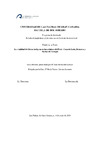Please use this identifier to cite or link to this item:
https://accedacris.ulpgc.es/jspui/handle/10553/70768
| Title: | La vitalidad del léxico indígena en las crónicas del Perú: Cieza de León, Betanzos y Pachacuti Yamqui | Authors: | Hernández Arroyo, Sara | Director: | Cáceres Lorenzo, M. Teresa | UNESCO Clasification: | 570201 Lingüística histórica 57 Lingüística |
Keywords: | Indian chronicle Vitality Synchrony Diachrony Spanish in America |
Issue Date: | 2019 | Abstract: | The Studies on lexical vitality, which are present in the Hispanic research tradition in the latest years, have verified that indigenisms are incorporated into the Spanish vocabulary in the first years of the conquest of the New World. In addition, its current vitality is evaluated based on several criteria: geographic diffusion, derivative training and creation of secondary meanings.The main objective of this paper is to recognize indications of the Indian vocabulary in three diverse origin chroniclers who produced their texts in the Andean area during the XVI and XVII centuries. These three texts were written to be read by ecclesiastical powers that persecuted idolatry in a colonial society and show themselves as connoisseurs of the Inca reality.
We will value the vitality through the elaboration of a synchronic lexical corpus extracted from chronicle texts. Our working hypothesis states that, in the chronicles of the Indies written in the area of Peru with the purpose of describing the customs and traditions of the Incas, it is possible to examine these indigenisms from the concept of current synchronic vitality.
Simultaneously, in the synchrony of the selected authors as a case study: the military Cieza de León, the interpreter Betanzos and the indigenous Pachacuti Yamqui. Equally, a specific number of voices may be quantified. This term classify shows a permanence in a general Indian vocabulary but, also, in a regional Spanish lexis. Likewise, it survives through different synchronicities and from a synchronic and geographical point of view.
The analysis of the words of Crónica del Perú, Suma y narración de los Incas and Relación de antigüedades deste reyno del Pirú by means of the mentioned indicator of vitality and following the criteria of productivity, semantic richness and, above all, geographic diffusion of the indigenism, will provide us with references on the veracity of our hypothesis. We have developed a lexicon of 257 voices that provide data on the different levels of vitality through a quantitative and qualitative methodology.
As we will observe, the voices that conform the lexical corpus, no all the voices that conform in the lexical corpus have or have had the same vitality. The results corroborate our initial paper hypothesis in a partial form, which supposes a contribution to the historical investigation of the American speaking, and the possibility of initiating new inquiries. Los estudios sobre la vitalidad léxica han verificado que los indigenismos se incorporan en el vocabulario panhispánico en los inicios. Además, su vitalidad actual se evalúa a partir de varios criterios: difusión geográfica, formación de derivados y creación de sentidos secundarios. El principal objetivo de esta investigación es reconocer indicios del vocabulario indiano en tres cronistas. Se trata de tres textos escritos con el propósito de describir las costumbres de los incas, para que fueran leídos por poderes eclesiásticos que perseguían la idolatría en la sociedad colonial. Mediante la elaboración de un corpus léxico sincrónico extraído de textos cronísticos valoraremos esa vitalidad. Nuestra hipótesis de trabajo plantea que, en las crónicas de Indias escritas en el área del Perú, también es posible examinar los indigenismos desde el concepto de vitalidad sincrónica actual y en la sincronía de los autores como un estudio de caso: el militar Cieza de León, el intérprete Betanzos y el indígena Pachacuti Yamqui. Asimismo, se puede cuantificar un número determinado de voces que evidencian la existencia de un vocabulario indiano general o regional que pervive a través de distintas sincronías. El análisis de los vocablos de Crónica del Perú, Suma y narración de los Incas y Relación de antigüedades deste reyno del Pirú, nos proporcionará referencias sobre la veracidad de nuestra hipótesis. A través de una metodología cuantitativa y cualitativa, hemos elaborado un lexicón de 257. Como veremos, de las voces del corpus, no todas tienen la misma vitalidad. Los resultados corroboran de forma parcial nuestra hipótesis inicial de trabajo, lo que supone una contribución a la investigación histórica de las hablas americanas, y la posibilidad de iniciar nuevas indagaciones. |
Description: | Programa de doctorado: Estudios Lingüísticos y Literarios en su Contexto Sociocultural | URI: | https://accedacris.ulpgc.es/handle/10553/70768 |
| Appears in Collections: | Tesis doctoral |
Page view(s)
357
checked on Jan 27, 2024
Download(s)
195
checked on Jan 27, 2024
Google ScholarTM
Check
Share
Export metadata
Items in accedaCRIS are protected by copyright, with all rights reserved, unless otherwise indicated.
